What’s the largest man-made lake in Nevada? After considering a variety of factors, and although a portion of the lake crosses the border into Arizona, Lake Mead still deserves the title of the largest man-made lake in Nevada. Not only is Lake Mead the largest man-made lake in the state, it’s also the largest reservoir in the United States! Not to mention one of the largest reservoirs (28th) in the world, providing water and hydroelectric power to millions of people in the Southwestern U.S. It is located on the Colorado River and has a maximum capacity of 26,134,000 acre ft (32.236 km3), and a surface area of 247 sq mi (640 km2). With 759 mi (1,221 km) of shoreline, Lake Mead is a popular destination for tourists and outdoorsmen alike. Keep reading to learn more about the largest man-made lake in Nevada!
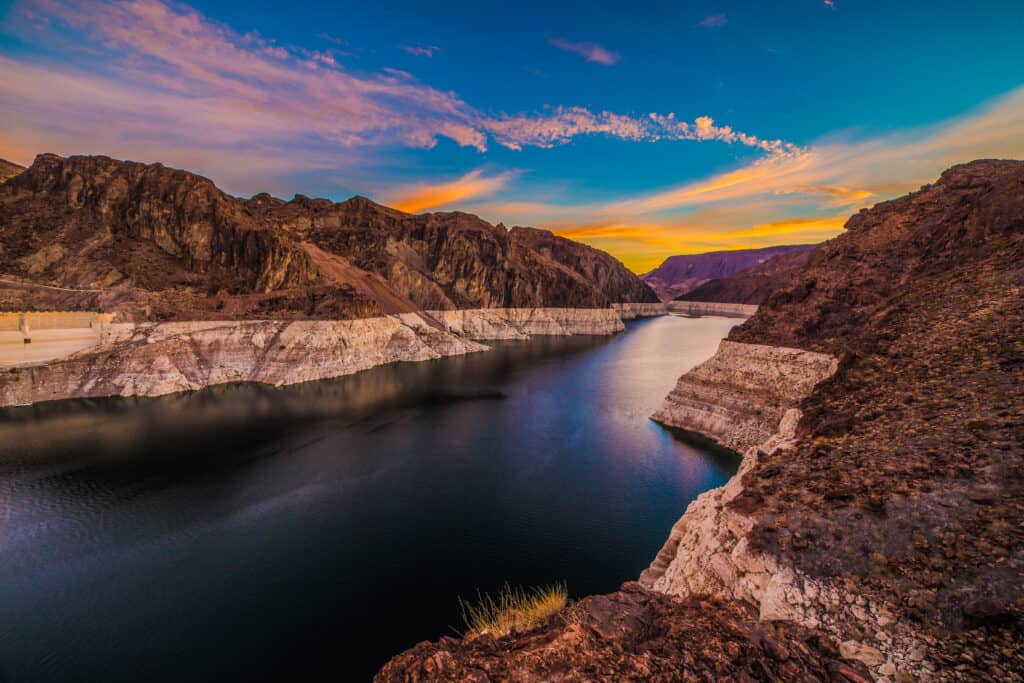
Not only is Lake Mead the largest man-made lake in Nevada, it’s also the largest reservoir in the United States!
©fellswaymedia/Shutterstock.com
Five Facts about Lake Mead
- Lake Mead is the largest man-made lake in the United States when measured by capacity
- Lake Mead is the 2nd largest reservoir in the United States when measured by surface area; the first is Lake Powell.
- Severe drought in the region has lowered the level of Lake Mead by 170 feet.
- The lake is named for Elwood Mead, a Bureau of Reclamation commissioner
- The Lake is in a North/South migration path
Hoover Dam
People from all over the world come to marvel at the sheer size and scale of Hoover Dam. The creation of Hoover Dam resulted in the formation of Lake Mead. Hoover Dam, built between 1931 – 1936, was a massive engineering project that involved thousands of workers and required the use of innovative construction techniques and equipment. The dam is a concrete arch-gravity dam on the Colorado River at the border between Arizona and Nevada. It was designed to control flooding, generate hydroelectric power, and provide water for irrigation and municipal use in the arid Southwest region of the United States.
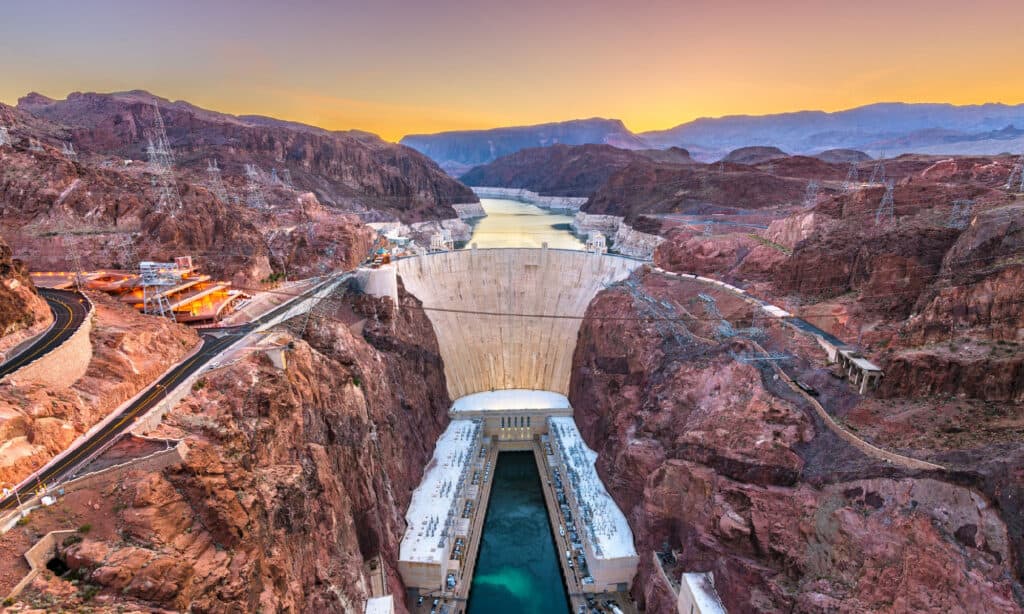
People from all over the world come to marvel at the sheer size and scale of Hoover Dam.
©iStock.com/Sean Pavone
The construction of the dam was an enormous undertaking. Over the course of the project, more than 21,000 workers were employed, with over 100 lives lost to accidents and illness. The dam was built in sections, using forms to shape the concrete into the desired arch shape. The construction of the dam also required the diversion of the Colorado River, which was accomplished through the construction of a network of tunnels and cofferdams. The diversion tunnels, which are still used today, allowed workers to redirect the flow of the river while the dam was being built. The completed dam is 726 feet tall and 1,244 feet long, and it contains more than 4.4 million cubic yards of concrete. Hoover Dam remains a wonder of engineering to this day.
Boulder Dam
The dam was initially named Boulder Dam, after nearby Boulder Canyon. The name Hoover Dam was not used until after Herbert Hoover, who was the Secretary of Commerce at the time the project was approved, became President of the United States. However, the name was not universally accepted, and there was some controversy over whether the dam should be named after a sitting president. The administration of President Franklin D. Roosevelt officially changed the name of the dam back to Boulder Dam in the early 1930s, but the name Hoover Dam was reinstated by an act of Congress in 1947 and has remained in use.
Displacement
The construction of the Hoover Dam and the creation of Lake Mead required the relocation of several thousand people and the flooding of numerous towns and communities in the area, including a large area of land along the Colorado River in parts of Arizona and Nevada. This area was largely rural and sparsely populated. However, many were given only six months’ notice to evacuate, forcing them to leave behind their homes, farms, and businesses. Though thousands of people were displaced by the construction of the dam and the creation of Lake Mead, the project brought significant benefits to the area, including flood control, power generation, and water storage. However, it also had a profoundly negative effect on the people and communities of the region.
Where to Find Lake Mead on a Map
If you’re planning a trip to Lake Mead, Nevada, it’s important to know where exactly the lake is located. Lake Mead is situated on the Colorado River, about 24 miles southeast of Las Vegas. It spans over 112 miles in length and has over 820 miles of shoreline. To locate it on a map, look for Boulder City or Henderson – both cities are adjacent to Lake Mead National Recreation Area. Additionally, if you’re driving from Las Vegas, take US-93 South towards Boulder City and follow signs for Lake Mead.
Lake Mead: Wildlife
Some of the most common wildlife at Lake Mead include bighorn sheep, coyotes, bobcats, and jackrabbits. Thanks to its location on a north-south migration route for many birds, species such as bald eagles, great blue herons, and ospreys are often visible at the lake. The area is also home to several species of reptiles, including rattlesnakes, Gila monsters, and desert tortoises. In addition to these native species, Lake Mead also supports a variety of introduced fish species, including rainbow trout, striped bass, and catfish.
Lake Mead: Plant Life
Lake Mead is in the Mojave Desert. A variety of plants have adapted to the harsh and arid environment. Some of the most common plants in the area include:
- Creosote Bush (Larrea tridentata): This is one of the most common plants in the Mojave Desert, and it’s well-adapted to the area’s hot and dry conditions. The plant has small, fragrant leaves and produces yellow flowers.
- Cactus: including the barrel cactus (Echinocactus and Ferocactus), the hedgehog cactus (Pediocactus simpsonii), and the cholla cactus (Cactaceae). These plants have thick, spiky stems and produce brightly colored flowers.
- Wildflowers: In the spring, the Lake Mead area is home to a wide variety of wildflowers, including poppies (Papaveraceae), lupine (Lupinus), and desert marigolds (Baileya multiradiata). These plants bloom briefly after winter rains and provide a burst of color in the desert landscape.
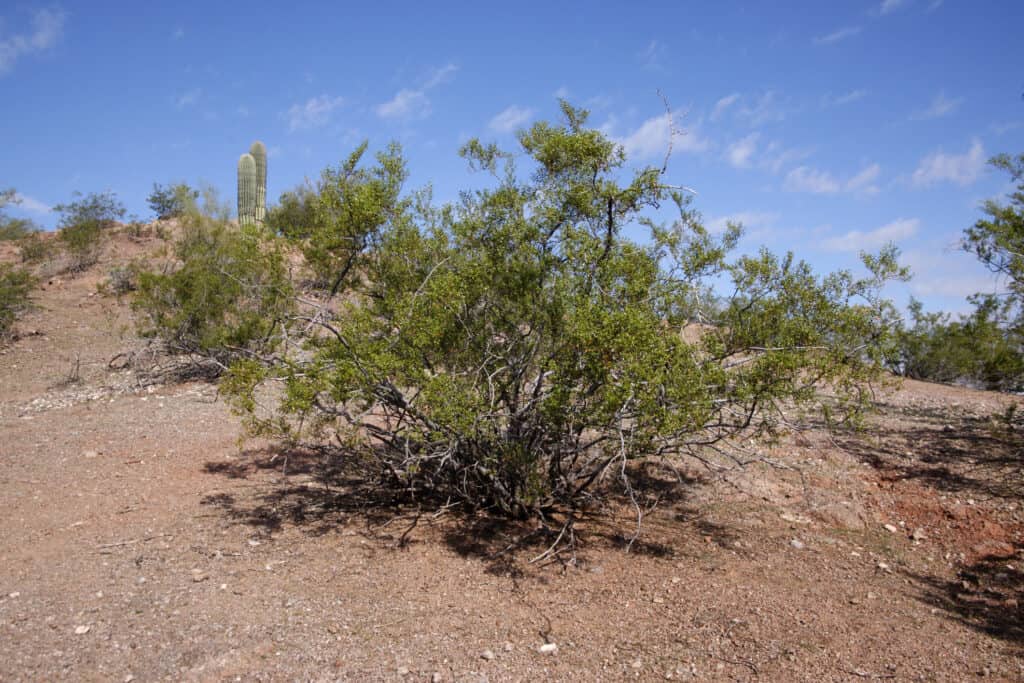
Creosote is one of the most common plants in the Mojave Desert.
©iStock.com/MikeLane45
While the plant life in the Lake Mead area may seem sparse at first glance, it’s actually quite diverse and has evolved to thrive in the desert environment. Visitors to the area should take care not to disturb the delicate balance of nature by staying on designated trails and avoiding trampling or removing any plants: Take nothing but photographs – leave with nothing but memories.
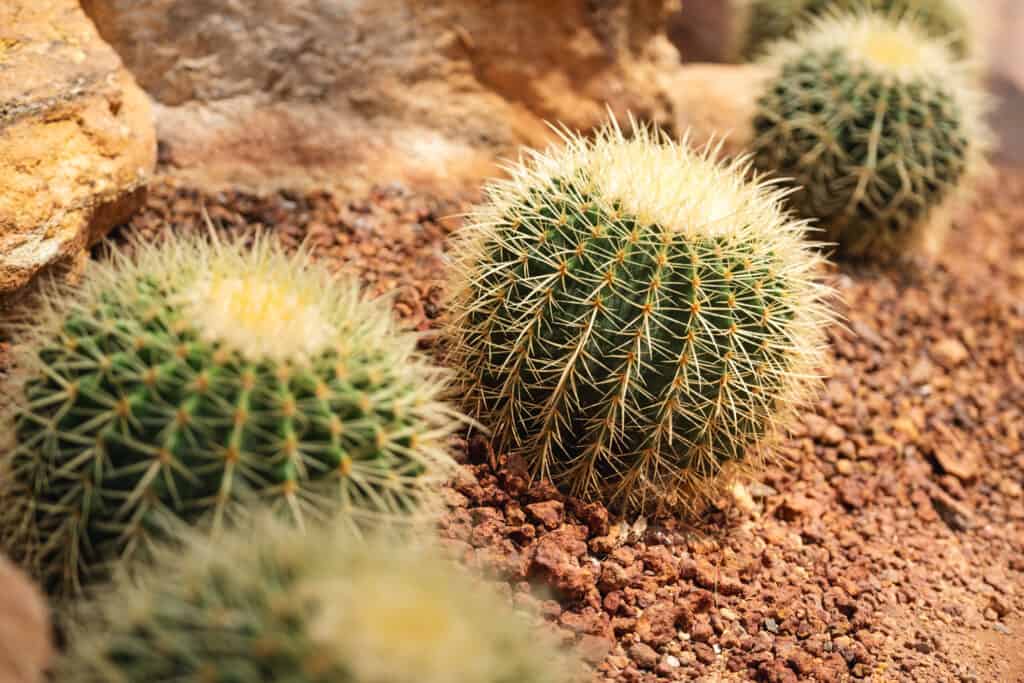
Barrel cacti are abundant around Lake Mead.
©iStock.com/Farknot_Architect
Lake Mead: Active Life
Lake Mead National Recreation Area is the principal park surrounding Lake Mead. It is operated by the National Park Service. The recreation area covers over 1.5 million acres and includes two large lakes, Lake Mead and Lake Mohave. Within the Lake Mead National Recreation Area, there are numerous opportunities for outdoor activities, including boating, fishing, hiking, camping, and wildlife viewing. The park also features a number of historic sites and scenic overlooks, including the Hoover Dam and the Mike O’Callaghan-Pat Tillman Memorial Bridge.
Lake Mead: Challenges
Though the lake Mead National Recreation Area remains open, the ongoing drought in the Western United States has resulted in a significant decrease in the water levels of Lake Mead. The lake is currently (2023) 170 feet below full pool. Full pool is defined as the maximum level a lake can support prior to water breeching the dam, either through spillways, or other discharge points. The lake is a critical source of water for millions of people in the region, and the declining water levels have raised concerns about water shortages and how they will affect the region.
Difficulties
There is no getting away from the receding water level at Lake Mead, as the evidence is visible everywhere. From the rocks jutting out of the lake at peculiar angles to the glaring bathtub ring that rims the lake’s rock wall, the proof is visible. The receding water level has made it more difficult for visitors to get to the lake, as paved roads and pathways now end several hundred yards from the shore. Imagine carting an ice chest and a beach umbrella the length of several bumpy, uneven football fields, and you’ll get a sense of the tribulations facing visitors to Lake Mead.
Intrigue and Invasive Species
The lower water levels have also exposed a number of interesting artifacts, including a WWII-era landing craft and a half dozen bodies. The landing craft was used to survey the Colorado River before being sold to a marina on the lake. At least one of the bodies, discovered inside a barrel, is believed to have been the target of a mafia hit. Forensics have determined that the barrel had been in Lake Mead since the 1970s-80s based on the victim’s shoes! Discoveries like these only add to Lake Mead’s storied history.
Lake Mead is further challenged by invasive species, including quagga mussels and zebra mussels, which have a significant impact on the lake’s ecosystem and water quality. The mussels clog water intake pipes and damage infrastructure. They can also disrupt the food chain and reduce the diversity of native species in the lake.
Precarious Future
Whether or not the water level at Lake Mead will continue to recede depends on a number of factors. Climate change has resulted in less precipitation and snowpack in the Colorado River basin, which supplies water to the lake, leading to a decrease in inflow. Ongoing drought conditions have further reduced the amount of water available. Lower intake coupled with increasing demand for water in the region does not bode well for Lake Mead. Without significant reductions in water usage or increased inflow, it is probable that the water level at Lake Mead will continue to drop in the coming years.
Lake Mead: Screen Time
One of the most famous movies to be filmed in the area is the 1963 classic It’s a Mad, Mad, Mad, Mad World, which features a number of scenes at Hoover Dam and along the shores of Lake Mead.
Other movies have been filmed at Lake Mead and the surrounding area including the 2001 comedy Rat Race, which was inspired by the movie It’s a Mad, Mad, Mad, Mad World! The popular TV series Breaking Bad also filmed several scenes in the area. The natural beauty and unique features of the area make it a popular filming location that continues to attract filmmakers and photographers who are drawn to its rugged landscapes and stunning vistas.
Lake Mead in the Wintertime
Winter at Lake Mead is usually mild and pleasantly chilly. During the winter months, the average temperature ranges from 60 degrees Fahrenheit (15.5 degrees Celsius) during the day, to around 40 degrees F (4.4 degrees C) at night. While snow is rare in the area, it is possible to experience occasional snow flurries or frosty mornings, especially at higher elevations. Visitors can enjoy hiking, sightseeing, and other outdoor activities during the winter months. The winter season tends to be less crowded than other times of the year, providing a quiet, peaceful experience.
Lake Mead: Day Tripping
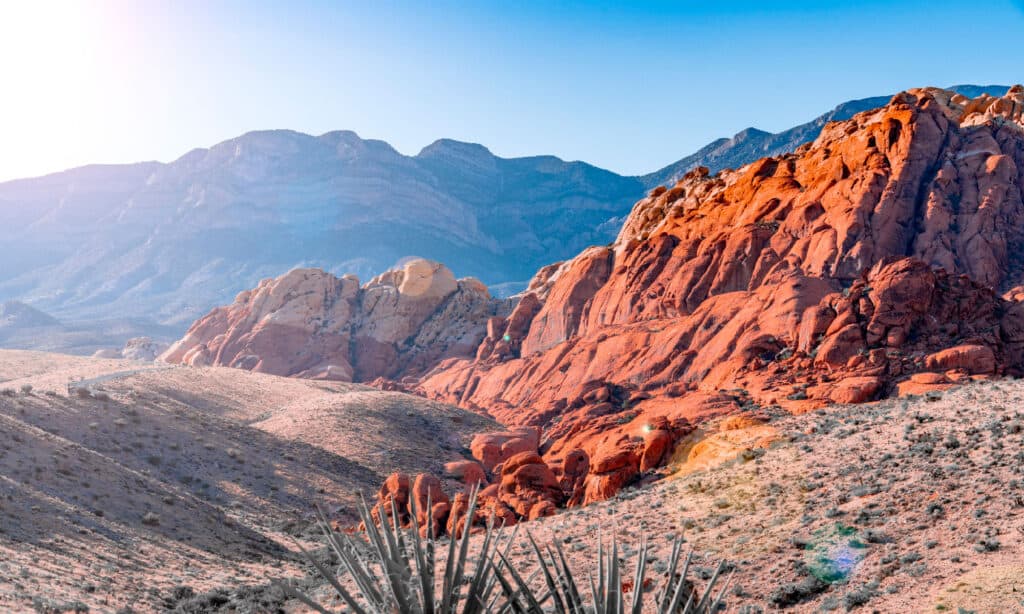
Red Rock Canyon is just up the road from Lake Mead.
©iStock.com/Pengcheng Zhu
If you’re visiting the area, Red Rock Canyon National Conservation Area makes for an intriguing day trip. Red Rock Canyon is home to a population of wild burros. These animals are descendants of the burros that were brought to the area by miners and settlers in the 1800s and have since adapted to the harsh desert environment of the Mojave. The burros can often be seen throughout the conservation area, particularly along the main road and near the visitor center. While the burros can be a fun and unique sight to see, it is important to remember that they are wild animals and should be treated with respect and caution.
The photo featured at the top of this post is © CrackerClips Stock Media/Shutterstock.com
FAQs (Frequently Asked Questions)
Is it true that Lake Mead and Hoover Dam have been the location for movies and television?
Yes, it’s true! One of the most famous movies to be filmed in the area is the 1963 classic It’s a Mad, Mad, Mad, Mad World, which features a number of scenes at Hoover Dam and along the shores of Lake Mead.
Other movies have been filmed at Lake Mead and the surrounding area including the 2001 comedy Rat Race, which was inspired by the movie It’s a Mad, Mad, Mad, Mad World! The popular TV series Breaking Bad also filmed several scenes in the area. The natural beauty and unique features of the area make it a popular filming location that continues to attract filmmakers and photographers who are drawn to its rugged landscapes and stunning vistas.
Is there a park located at Lake Mead?
Yes! Lake Mead National Recreation Area is the principal park surrounding Lake Mead. It is operated by the National Park Service. The recreation area covers over 1.5 million acres and includes two large lakes, Lake Mead and Lake Mohave, as well as several other smaller bodies of water. Within the Lake Mead National Recreation Area, there are numerous opportunities for outdoor activities, including boating, fishing, hiking, camping, and wildlife viewing. The park also features a number of historic sites and scenic overlooks, including the Hoover Dam and the Mike O’Callaghan-Pat Tillman Memorial Bridge.
Will Lake Mead ever again be at full capacity?
It is doubtful that Lake Mead will ever again reach full capacity. Whether or not the water level at Lake Mead will continue to recede depends on a number of factors. Climate change has resulted in less precipitation and snowpack in the Colorado River basin, which supplies water to the lake, leading to a decrease in inflow. Ongoing drought conditions have further reduced the amount of water available. Lower intake coupled with increasing demands for water in the region does not bode well for Lake Mead. Without significant reductions in water usage or increased inflows, it is probable that the water level at Lake Mead will continue to drop in the coming years.
is it true that lower water levels at Lake Mead are exposing corpses?
Yes, it is true that the lower water levels have exposed at least 6 bodies. At least one of the bodies, discovered inside a barrel, is believed to have been the target of a mafia hit. Forensics have determined that the barrel had been in Lake Mead since the 1970s-80s based on the victim’s shoes! Another body has been identified as that of a man who went missing during a midnight excursion with his family in 2002. Still another body was discovered inside an automobile.
Does Lake Mead freeze over in the winter?
No! Lake Mead does not freeze over in the winter. Winter at Lake Mead is usually mild and pleasantly chilly. During the winter months, the average temperature ranges from 60 degrees Fahrenheit (15.5 degrees Celsius) during the day, to around 40 degrees F (4.4 degrees C) at night. While snow is rare in the area, it is possible to experience occasional snow flurries or frosty mornings, especially at higher elevations. Visitors can enjoy hiking, sightseeing, and other outdoor activities during the winter months. The winter season tends to be less crowded than other times of the year, providing a quiet, peaceful experience.
Thank you for reading! Have some feedback for us? Contact the AZ Animals editorial team.






